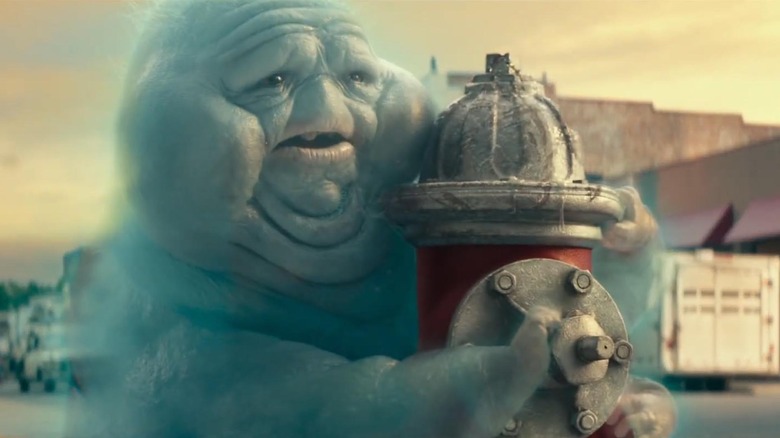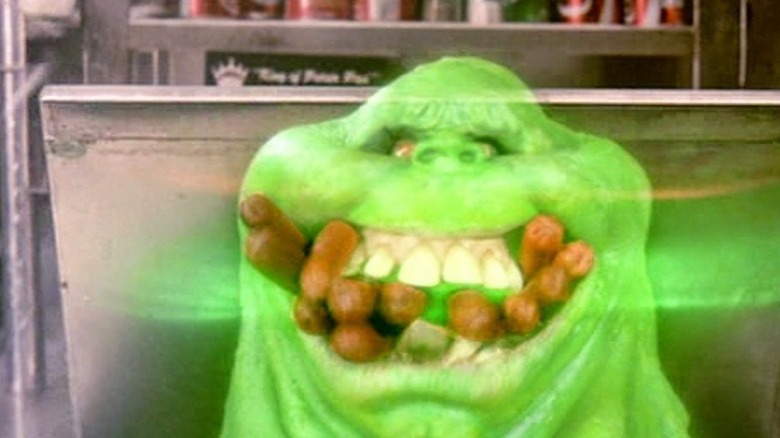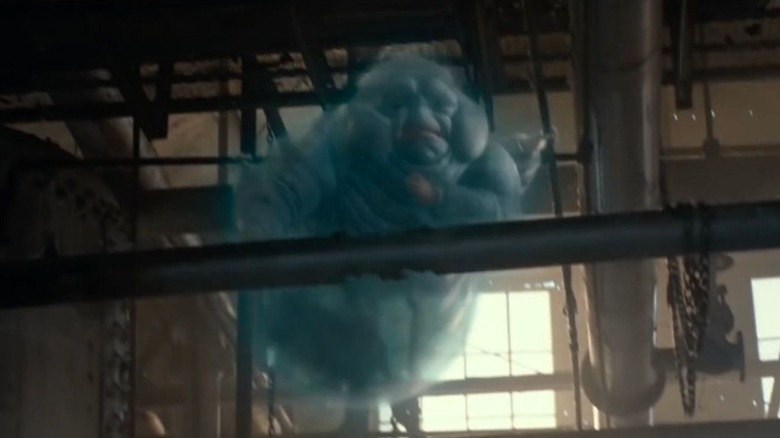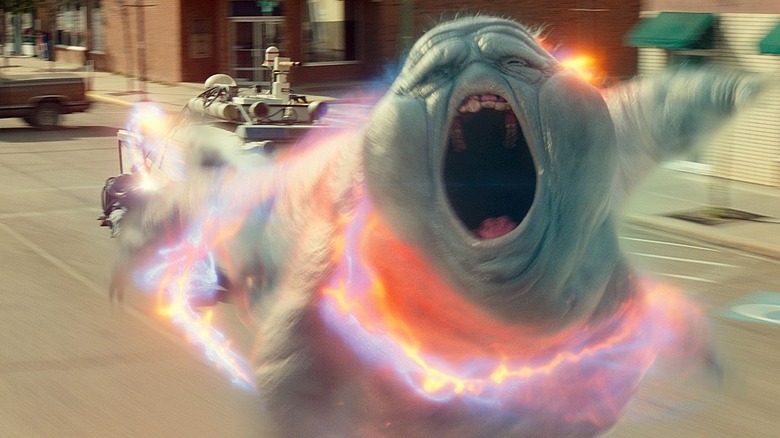
Upon the release of "Ghostbusters: Afterlife" in 2021, one name was on everyone's lips: Muncher. The free-floating, metal-chewing ectoplasmic apparition slimed his way into everyone's hearts, causing audiences worldwide to instantaneously forget about other, formerly "cute" characters like Grogu (aka Baby Yoda), WALL-E, Mickey Mouse, and even their own pets and children.
Okay, so maybe Muncher Mania only exists inside this writer's weirdo brain, but that doesn't mean the crew of "Afterlife" didn't have lofty goals for the character. As creature designer Brynn Metheney explained in author Ozzy Inguanzo's book "Ghostbusters: Afterlife: The Art and Making of the Movie," the goal for creating Muncher and the film's other new ghost creatures was "all about being iconic, keeping it simple, and really getting down to the essence of what the character is."
By studying the designs of the original 1984 "Ghostbusters," Metheney and director Jason Reitman were already on the right track when they started to create Muncher, yet they didn't arrive at the final look without help from two unlikely inspirations: "The Lord of the Rings'" Bilbo Baggins, and, well, the special vibe elderly grandmothers have.
Designing The Ghosts Of 'Ghostbusters' Can Be Tricky — And Spooky

Brynn Metheney was no novice at creating characters before "Afterlife," having worked as a concept artist on such visually striking films as "Valerian and the City of a Thousand Planets" and "Men in Black: International." She's well aware that designing a memorable character requires making them simple enough for a child to draw, yet also giving them "something that the audience can latch onto — an iconic feature for them to remember."
Creating a new "Ghostbusters" character is easier said than done, given the history of colorful and wacky-looking ghosts seen over the various films (never mind the hours of spinoff cartoon episodes). The aim with Muncher's design was to make him rival the original film's Onionhead, aka Slimer, and, as quoted in "Ghostbusters: Afterlife: The Art and Making of the Movie," Metheney knew: "Most people could draw Slimer from memory because of how simple that design is. He has a universal appeal."
Of course, nothing about designing Slimer was simple to begin with. When "Ghostbusters" creature designer Steve Johnson was given the brief toward the end of the design process to give Slimer the likeness of the recently departed John Belushi, the artist told Bloody Disgusting he "pulled out a stack of headshots of John Belushi, poured a gram of cocaine on it and started chopping lines up." Johnson allegedly even saw Belushi's ghost, who modeled for him while he worked into the night. Clearly, Metheney had her work cut out for her with Muncher.
Old Grandmas And Water Bears: Muncher's Vibe Gets Built

Narrowing down the look of Muncher caused Brynn Metheney to go through numerous sketches, concepts, and revisions, with the designer trying to find "this character that Jason was chasing in his mind." As Metheney recalled in the book, Reitman wanted the character "to feel like a lazy, lethargic, grumpy little gremlin who was really into his metal." When Metheney presented the director with a sketch that featured a Muncher with a particularly grumpy and elderly look, Reitman was thrilled. "'This is the vibe I've been wanting. This old grandma vibe,'" he said to Metheney.
In addition to his vibes, Muncher's physiology also changed over the course of many different designs. The biggest influence in terms of the ghost's physicality came when Reitman saw images of tiny little animals called tardigrades, which are also known as "water bears" and "moss piglets." As Metheney explained, "Jason was really into the chubby bodies of these microscopic creatures, and the six-legged thing became a fascination for everybody." Now outfitted with six limbs and "a translucent blue sparkly kind of color" Metheney considered to be the most appropriate color for a ghost, the creature was almost ready for his big-screen debut.
With A Little Hobbit Attitude, Muncher Is Born

One of the key elements of the ghosts in the "Ghostbusters" franchise is their ability to turn on a dime from cute and funny to genuinely menacing, a conceit established by the first film's Library Ghost, Stay Puft Marshmallow Man, and yes, even Slimer. Jason Reitman and Brynn Metheney were very aware of this, knowing Muncher should be "this wavy little creature that — when he's not upset or feeling threatened — is kind of cute," only to have him turn aggressive upon being confronted.
To best portray the sudden change of look and mood, Metheney recalled this scene in 2001's "The Lord of the Rings: The Fellowship of the Ring," where an old Bilbo Baggins (Ian Holm) falls briefly under the One Ring's spell, Gollum-like, when he sees the Ring again. "I remember how calm and sweet and lovely his face was initially," Metheney explained. "You go from sympathizing with this character at first, because he's so cute, and then suddenly he's not. It's really about the expression and how the trust is violated. That's actually a pretty scary transition."
Thus, with the vibes of an old grandma, the look of a grumpy chubby microscopic creature, a Slimer-like appetite, a sudden violent temper and the vocal stylings of Josh Gad, Muncher was born. However you feel about "Afterlife" and Muncher, I can only express my deep affection for him in a similar way to Cassie of "Ant-Man" and hold out hope that Muncher Mania could still happen in the future.
Read this next: The Best Movies Streaming Right Now: Malignant, A Hero, And More
The post Ghostbusters: Afterlife Emulated Bilbo Baggins and an Old Grandma to Create Muncher appeared first on /Film.
0 Commentaires